Enhance Content Delivery with CDN Integration in Headless CMS

What’s Inside
- What Is a CDN?
- Why Do You Need a CDN?
- How CDNs Help Organizations Achieve SEO Objectives?
- How CDN Works?
- CDN Architecture Components That Make This Happen!
- Selecting the Right CDN for Headless CMS
- Challenges That Come in the Way of Integrating Cdn in Headless CMS
- Tips to Overcome Problems While CDN Integration
- Case Studies: Brands That Use It!
- Experro – A CDN-enabled Headless CMS
- Conclusion
Key Takeaways
- CDN and headless CMS together ensure fast, engaging web experiences.
- This synergy offers benefits like consistency, security, cost savings, and improved content availability.
- They play a crucial role in improving website speed, which is vital for SEO and user experience.
- The CDNs route user requests and deliver cached content for faster loading.
- Consider a Headless CMS like Experro with integrated CDN for simplicity and enhanced performance.
- Experro offers a streamlined solution with integrated CDN capabilities.
Ever visited a website where everything loads quickly?
The images appear instantly, and videos play smoothly. No waiting, no frustrating pauses - just a seamless experience that keeps you engaged. How is this possible?
Well, it's all due to a powerful duo of CDN integration and Headless CMS.
A CDN acts like a geographically distributed network of super-fast delivery vehicles spread across the world. But the real thing happens when you integrate it with a Headless CMS.
Together, they ensure that your audience promptly accesses your essential content, no matter where they are.
A Headless CMS allows you to separate content management from how it appears on a website. It's like having a blank canvas where you can create website content that fits any platform or device. And when you combine it with a CDN, your canvas expands even further.
With web servers and data centers located worldwide, caching your content, load is distributed, keeping your website fast and reliable even during peak usage.
This blog will explore CDN integration in Headless CMS in more detail. So, let's dive in!
What Is a CDN?
Let's imagine your website is based in California.
When a user accesses your web content, content from your San Francisco server—including pictures, CSS, videos, and JavaScript—is collected and shown to the end user. This works well till the user is also located in or anywhere within California.
However, if website users from distant or multiple geographical locations like India, Canada, or Austria access your web pages, the content has to travel a long distance before reaching them.
Additionally, the website server may get overloaded and take longer to handle the load. It may even delay reacting to server requests if several users make concurrent requests for the same piece of internet content.
As a result, content delivery speed is impacted, leading to higher latency and longer page-load times or slow loading site.
A Content Delivery Network (CDN) can help you with this problem!
A content delivery network or a distribution network consists of a network of servers strategically placed to cache content near end users. Thus, making content available all around the globe through nearby CDN server for your web page users.
Curious about what is headless CMS and how it works? Learn how to leverage it for single or multi-site projects in our blog.
Why Do You Need a CDN?
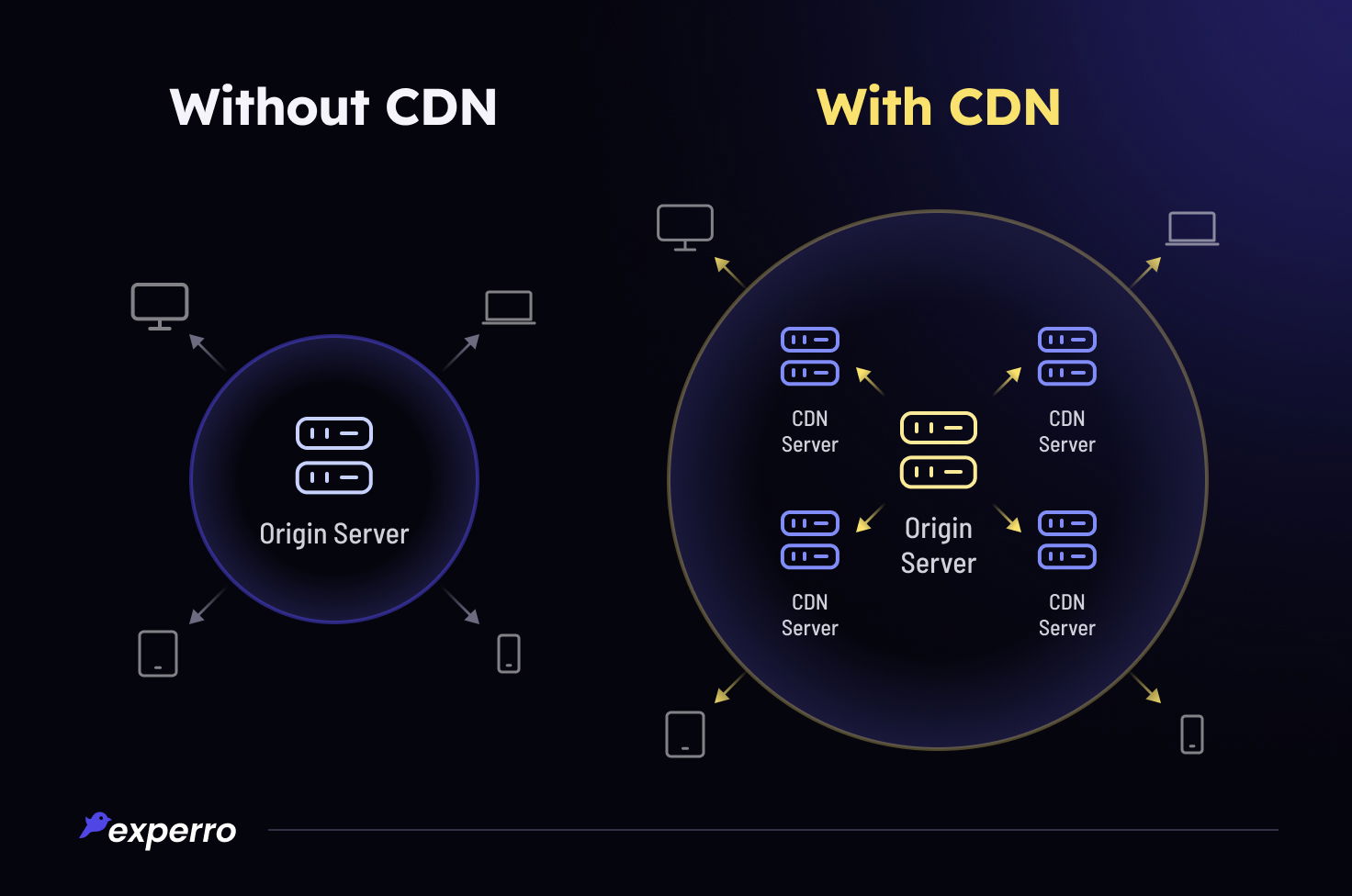
For effective content distribution, greater security, scalability, and cost savings, a CDN is highly essential.
It ensures faster loading times, reduces latency, handles high traffic spikes, protects against DDoS attacks, and optimizes global content distribution. Below are some more points to reemphasize this:
1. Consistency
A CDN ensures consistent content delivery worldwide, regardless of user location, resulting in a smooth and reliable user experience. It uses static and dynamic content to provide this consistency.
2. Security
Your website will be protected from DDoS (distributed denial of service) attacks and SSL encryption thanks to a CDN, preserving both its integrity and the good name of your business.
3. Data Insights
You may make sound decisions and improve your content first marketing strategy using a CDN, which offers insightful data insights and analytics on user behavior, web traffic trends, and content performance.
4. Potential Savings
By offloading bandwidth consumption and reducing server load, a CDN can save you on hosting costs and infrastructure expenses.
5. Better Content Availability
A CDN replicates your content across multiple cdn edge servers, ensuring faster access and reduced latency, improving availability, and reducing downtime.
6. Improved Security
A CDN replicates your content across multiple servers, ensuring faster access and reduced latency, improving availability, and reducing downtime.
How CDNs Help Organizations Achieve SEO Objectives?
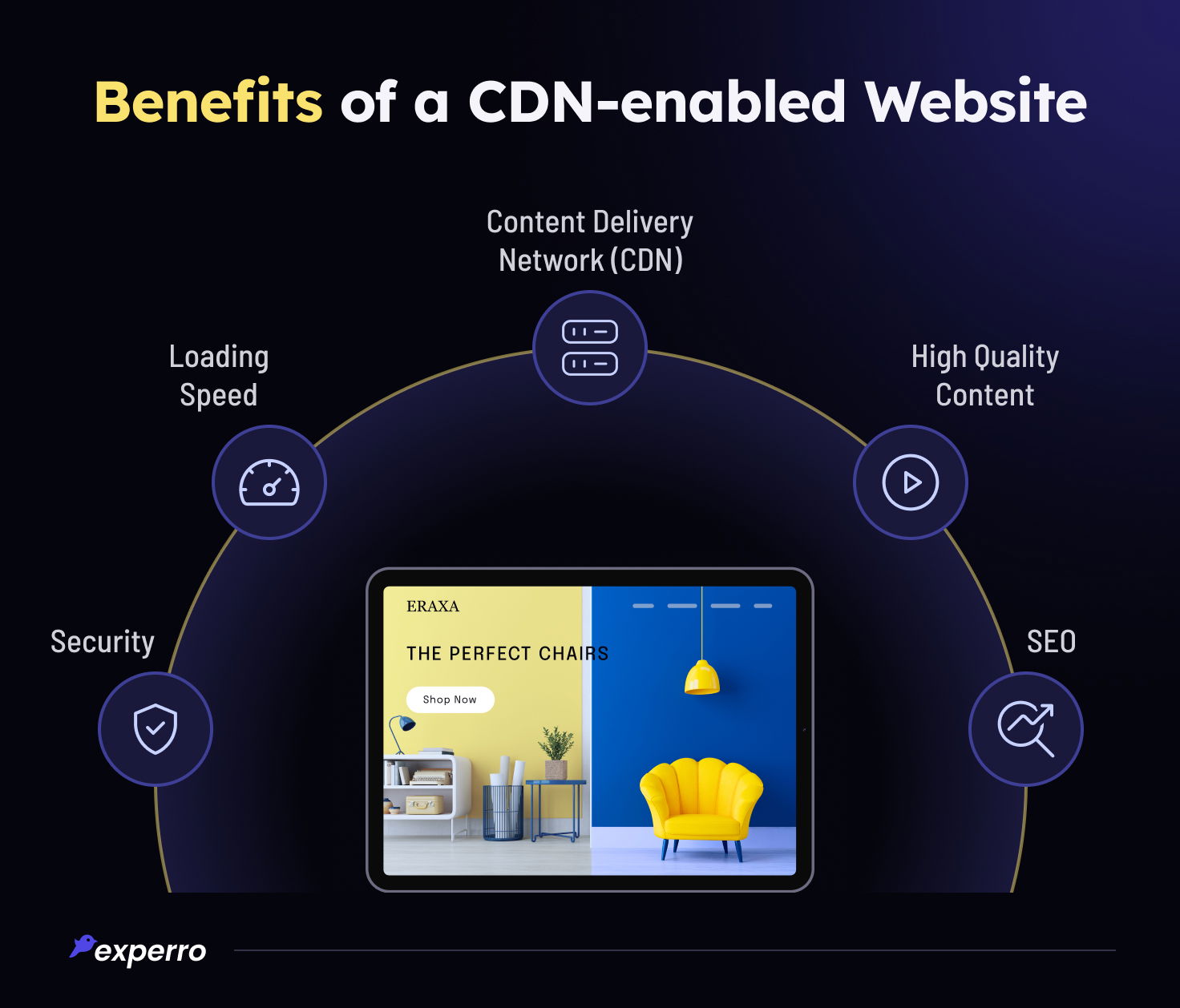
CDNs are now considered industry standards (especially in enterprise SEO), and their worth in Headless CMS & SEO – will continue to climb as content marketing spending rises.
Any SEO expert worth their salt will tell you that page and user experience, as well as website ranking, are both greatly impacted by speed.
The importance of page experience to Google is not exactly a secret. It has taken the organization a lot of work to create incentives for effective online rendering that disrupts users as little as possible.
A user is more likely to give up and move on the longer material takes to generate and load. A lead or money is lost for every rage quit on a website that wouldn't load.
Speed is also intimately related to the Core Web Vitals in headless CMS.
A web server might go down and consumers would not be able to access a website or service as a consequence of hardware issues and traffic surges brought on by malicious threats.
A CDN' core network infrastructure enhances your website's security and UX capabilities by assuring safe data distribution, secure encryption, and transmission, an up-to-date SSL, and balanced traffic loads.
A comprehensive CDN contains many elements that will reduce downtime. Rapid increases in network traffic may be scaled more easily thanks to load balancing, which equally distributes traffic across numerous servers.
This aids in defending your company from denial-of-service (DDoS) assaults, where the sinister objective is to increase traffic in an effort to overwhelm and crash a server.
By 2023, DDoS (distributed denial of service) assaults are anticipated to more than treble, reaching over 15 million annually. These are easily handled with the help of CDN integration.
Your desire to obtain a CDN as soon as possible may increase now that you are aware of everything!
But we know a better solution for your SEO needs that don't require you to create or buy a CDN. And the best part is you can take care of it without spending an extra penny. Keep reading to know more!
How CDN Works?
A content delivery network operates through the following steps:
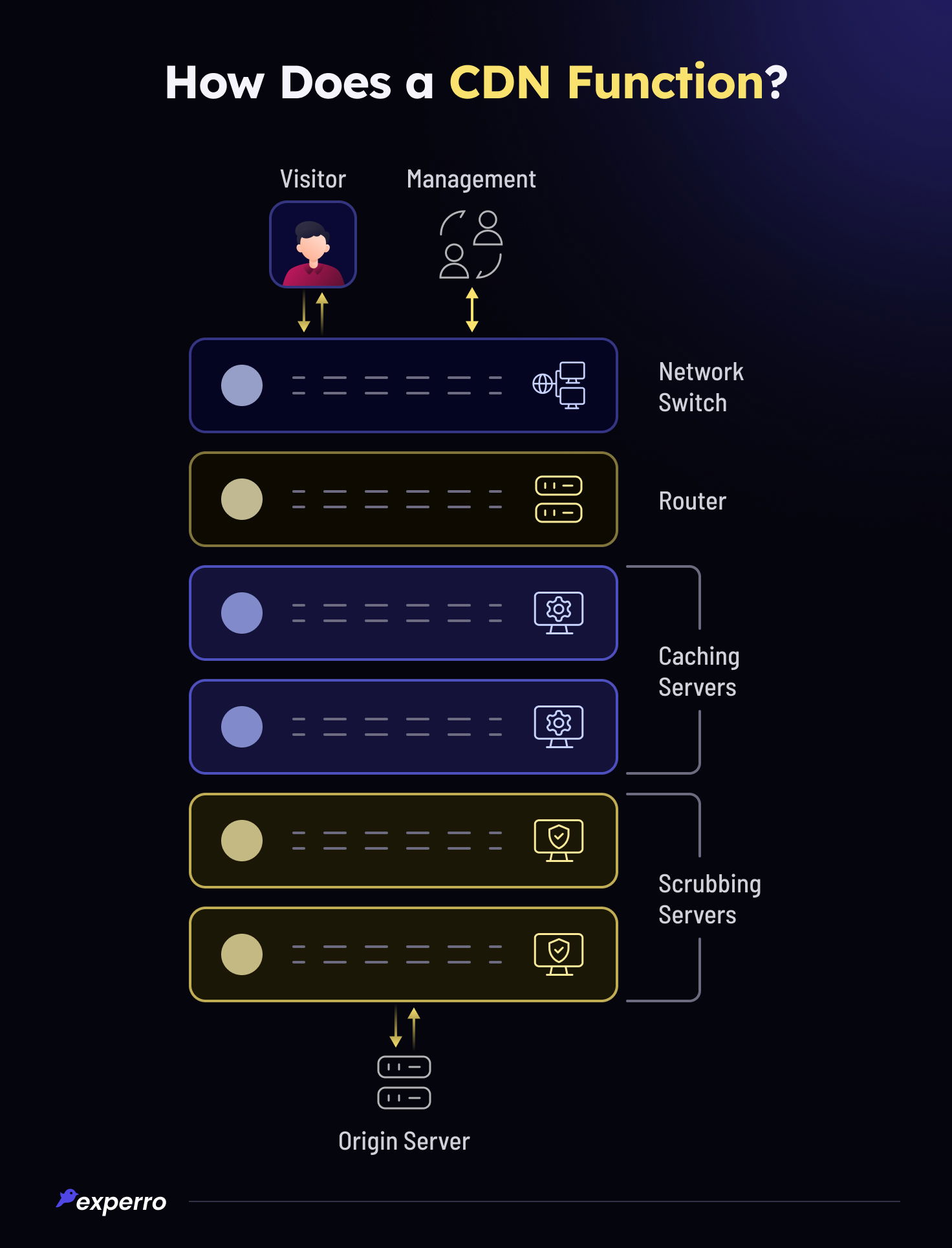
1. User Request: To display web pages, some web resources, like HTML, CSS, JavaScript files, media files and image content is asked for by the user's device or user agent. These files are available on web hosting servers.
2. Optimum CDN Server: The request is directed to the most suitable CDN server based on factors like proximity, server load, and network conditions.
3. Cached Content: The CDN server checks if it has a previously cached version of the requested content. If available, it promptly delivers the cached content to the user.
4. Retrieval from Alternate Server: If the requested content is not found on the initially selected server, the CDN platform retrieves the files from another server within its network.
5. Origin Server Retrieval: A request is sent to the origin server, where the initial information is kept; this is done when the requested content is either out-of-date or unavailable on any CDN server inside the network.
6. Caching for Future Requests: The newly retrieved content from the origin server is stored in the CDN's cache to fulfill future requests efficiently.
By following these steps, a content delivery network optimizes content delivery by serving cached content from nearby servers and retrieving content from the origin server when necessary.
CDN Architecture Components That Make This Happen!
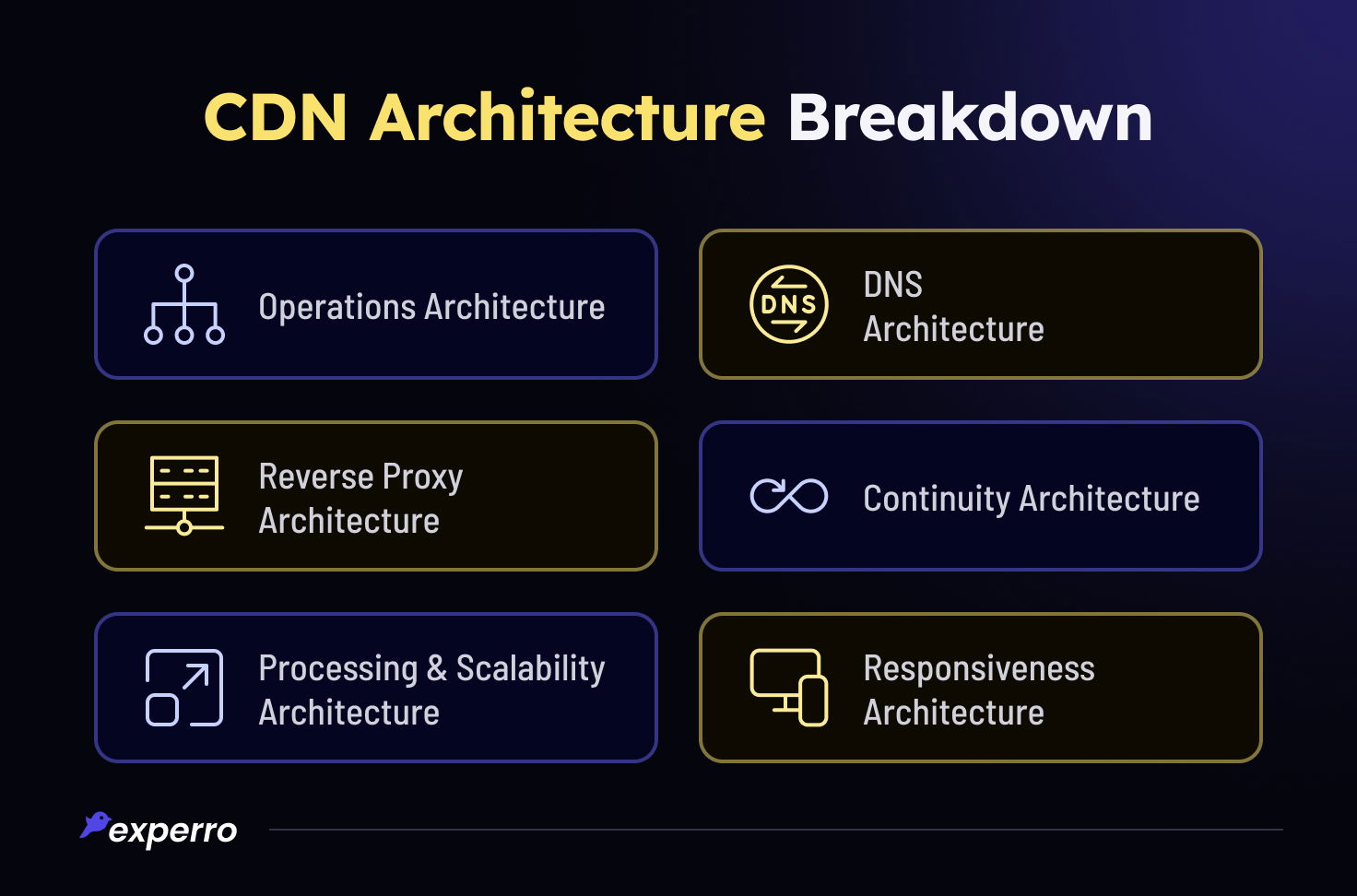
1. Operations Architecture
- Manages and maintains the CDN infrastructure, including server deployment, configuration, and monitoring.
- Handles tasks such as content replication, caching rules, load balancing, and content purging.
2. DNS Architecture
- Uses DNS (Domain Name System) to route user requests to the nearest edge server based on geographic location.
- Enables efficient traffic distribution and reduces latency by directing users to the optimal CDN server.
3. Reverse Proxy Architecture
- It employs reverse proxy content delivery network servers positioned at the network edge to receive user requests and retrieve content on behalf of the origin server.
- Provides caching, security, and load balancing capabilities, delivering content quickly and reducing server load.
4. Continuity Architecture
- Ensures uninterrupted content delivery by offering failover and redundancy mechanisms.
- Replicates content across multiple CDN servers, enabling seamless content retrieval even if specific servers become unavailable.
5. Processing and Scalability Architecture
- Enables efficient handling of high-traffic loads by distributing requests across multiple CDN servers.
- Utilizes load-balancing algorithms and scalable infrastructure to ensure optimal resource utilization and performance.
6. Responsiveness Architecture
- Focuses on minimizing latency and delivering content quickly to end users.
- Leverages edge servers located closer to users, caching mechanisms, and optimized routing to enhance responsiveness.
By combining these architectural components, CDNs create a robust infrastructure that optimizes content delivery, improves scalability, enhances user experience, and ensures reliable and responsive performance.
Selecting the Right CDN for Headless CMS
When it comes to selecting a CMS with integrated CDN capabilities, choosing a Headless CMS with an inbuilt CDN is a wise decision.
It offers simplified integration, enhanced performance, cost-effectiveness, seamless content management, and centralized analytics.
By leveraging the power of an inbuilt CDN within your Headless CMS, you can efficiently deliver web content experiences to your users, ensuring their customer satisfaction and driving the success of your digital initiatives.
But we recommend choosing the one that supports 140+ CDNs globally, and Experro offers you precisely that!
Challenges That Come in the Way of Integrating Cdn in Headless CMS
For content providers, service providers, or operators looking to launch a CDN, one significant hurdle is the initial investment required for the fundamental infrastructure.
This includes the streaming servers containing the content, proxies, and caching servers. This phase also includes bandwidth costs.
As well as it includes network management software responsible for governing content exchange, fetching, transcoding, and streaming functionalities.
However, a challenge faced by vendors in the global CDN market is the high prices of CDN solutions. Third-party vendors or CDN providers of these solutions give their CDN services for a premium over the going rate.
Hence, making your own CDN or buying one only helps if you spend a lot of money!
Whereby there are some other challenges that you will face even if you choose to buy from these CDN - Content delivery network services which are mentioned below:
1. Compatibility
Ensuring compatibility between the CDN and the Headless CMS may be challenging. It is important to ensure that both systems can seamlessly work together without technical complications. Such as for software downloads, a heavy system is required to deliver content.
2. Configuration Complexity
Configuring the CDN settings to work effectively with the Headless architecture can be complex. Fine-tuning caching rules and managing dynamic content may require some technical knowledge or assistance.
3. Content Synchronization
Keeping the content in sync between the Headless CMS and the CDN may present challenges. Ensuring that changes made in the CMS are reflected accurately and promptly in the CDN cache is important.
4. Cache Invalidation
Managing cache invalidation can be tricky, especially when removing outdated or invalid content from the CDN cache. Careful planning and execution are necessary to guarantee that viewers always receive the latest content.
5. Cost Considerations
CDNs or content delivery networks may come with associated costs such as bandwidth usage fees and storage costs. It is essential to think about the price model and make sure the integration is still affordable for your particular needs.
6. Performance Monitoring
Monitoring the performance of the CDN integration within the Headless CMS is essential. It is important to have access to user-friendly monitoring tools that provide insights into the performance and ensure optimal content delivery.
Tips to Overcome Problems While CDN Integration
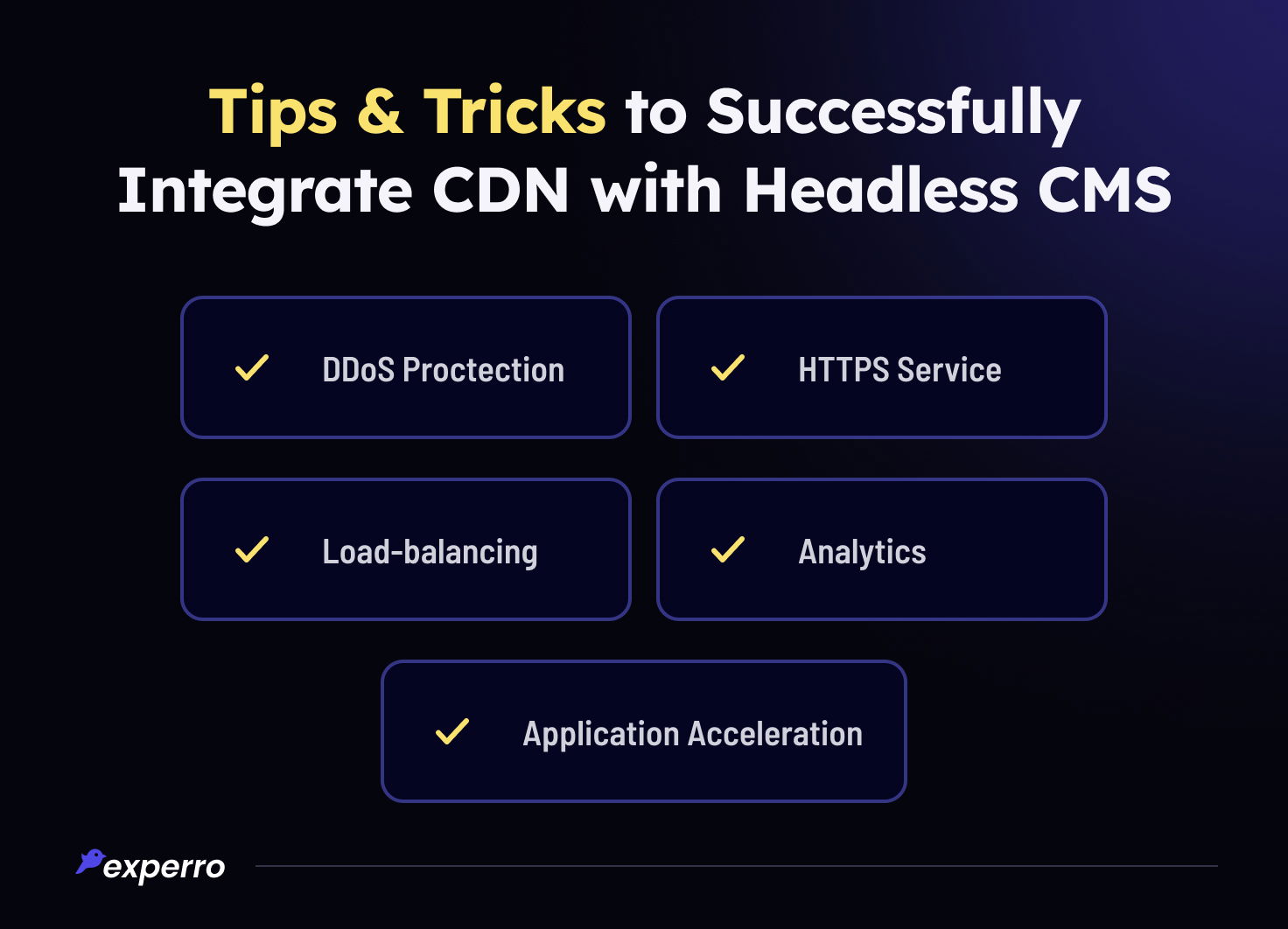
1. Check its API Compatibility
Ensure API compatibility between your content management system (CMS) and the CDN provider. Confirm that the CDN's API can seamlessly integrate with your CMS, allowing for smooth communication and data exchange.
2. Properly Configurate
Pay close attention to the configuration process. Configure the CDN settings correctly, including caching rules, cache invalidation, cached files and content synchronization. The proper configuration ensures optimal performance and prevents potential issues.
3. Test and Monitor
Thoroughly test the CDN integration before going live to reduce bandwidth consumption. Conduct comprehensive testing to ensure proper content delivery, caching, and performance.
Continuously monitor the CDN performance, uptime, and user experience to identify and address any issues promptly. This will simultaneously result in reducing bandwidth costs.
4. Don’t buy. Choose an inbuilt one!
We recommend not buying any CDNs; you should not even think about creating your own in this pool of CDNs.
Instead, you should pick a headless CMS with inbuilt CDN availability so that you don’t even need a developer to handle things for you!
There are some, if not many, Headless CMS + content delivery network providers that have 140+ CDNs in them, and guess what? Experro is one of them!
Case Studies: Brands That Use It!
Some real brands or companies have implemented CDN integration in their headless CMS to enhance content delivery. Let’s have a look at them:
1. Netflix
Netflix, a popular streaming service, relies on CDN integration to deliver high-quality video content to millions of subscribers worldwide.
By leveraging CDN technology, its website owners ensure fast and seamless streaming experiences across different device(s) (like mobile devices) and physical location(s).
2. The New York Times
The New York Times, a renowned news publication, utilizes CDN integration to optimize the delivery of its articles, images, and multimedia content.
This helps them reach a global audience efficiently and provides a smooth reading experience.
3. Airbnb
Airbnb, a leading online marketplace for vacation rentals, implemented CDN integration to enhance the performance of its platform.
By leveraging CDN technology, they ensure that their property listings, images, and other dynamic content load quickly, providing a seamless booking experience for users.
4. Spotify
Millions of customers of the well-known music streaming service Spotify depend on CDN integration to deliver audio content.
With CDN-enabled content caching and distribution, they ensure minimal buffering and a smooth music streaming experience across devices.
Experro – A CDN-enabled Headless CMS
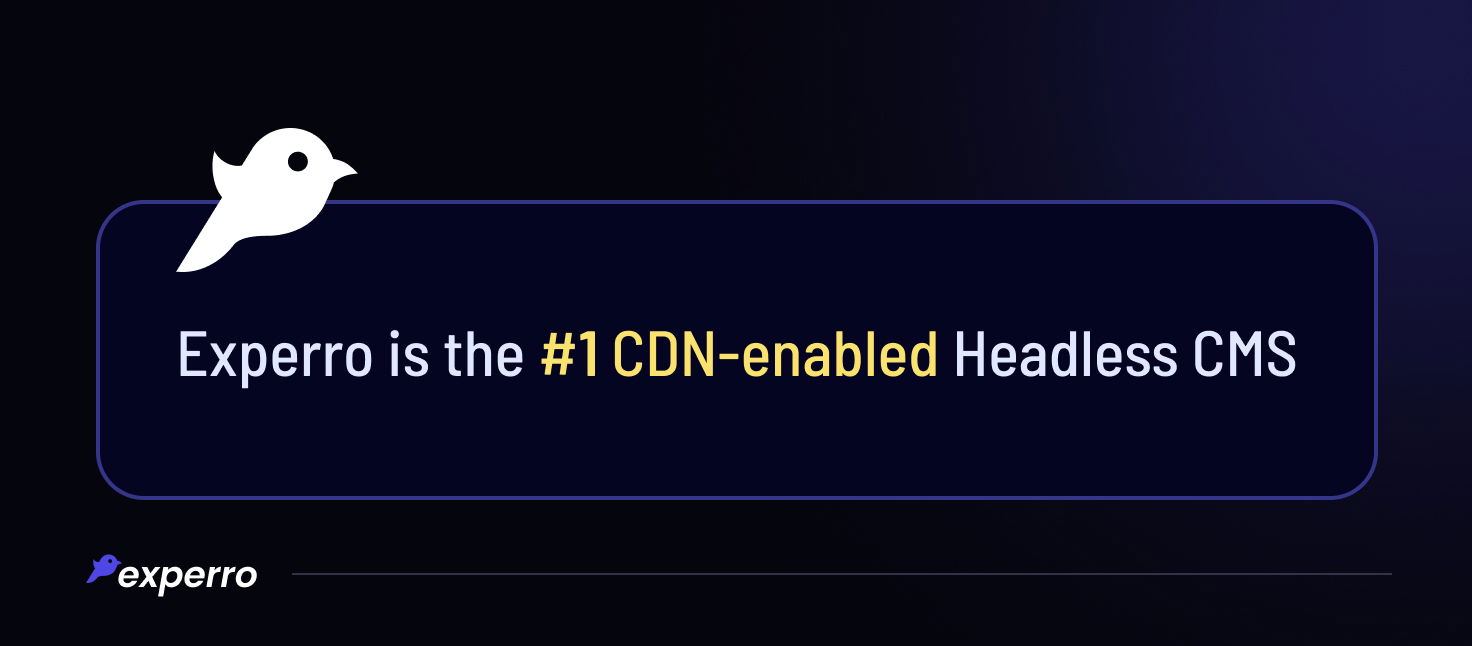
When it comes to selecting a powerful solution that combines the benefits of a Content Delivery Network (CDN) with a Headless CMS, Experro is the perfect choice.
Apart from robust cloud content management capabilities, Experro offers a comprehensive and seamless integration of CDN within its Headless CMS platform itself.
You don’t need to go searching for third-party vendors for CDN, whereby creating the CDN is also not needed anymore. You can directly use the CDN available in Experro’s CDN without spending an additional cost for this.
With Experro, you can enjoy simplified content delivery, enhanced performance, and efficient content management. Say goodbye to compatibility issues and complex configurations.
Opt for Experro and unlock the full potential of your website with its CDN-enabled Headless CMS solution.
Conclusion
Integrating a CDN with a Headless CMS brings improved content delivery, enhanced user experience, and optimized performance.
Choosing Experro's CDN-enabled Headless CMS simplifies integration, ensures compatibility, and enables seamless content management and delivery.
With Experro, you can efficiently deliver exceptional content experiences and drive the success of your digital initiatives!
Frequently Asked Questions


Mehul Shah
30 October 2023A digital marketer with an uncommon funny bone and a knack for perfection, Mehul has been writing about how going headless can help eCommerce stores & businesses for quite some time now! He is a digital marketer and a geek in Inbound marketing who likes to spend most of his time researching ways technology influences your daily life (positively).